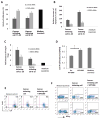Glioblastoma cancer-initiating cells inhibit T-cell proliferation and effector responses by the signal transducers and activators of transcription 3 pathway
- PMID: 20053772
- PMCID: PMC2939737
- DOI: 10.1158/1535-7163.MCT-09-0734
Glioblastoma cancer-initiating cells inhibit T-cell proliferation and effector responses by the signal transducers and activators of transcription 3 pathway
Abstract
Glioblastoma multiforme (GBM) is a lethal cancer that responds poorly to radiotherapy and chemotherapy. Glioma cancer-initiating cells have been shown to recapitulate the characteristic features of GBM and mediate chemotherapy and radiation resistance. However, it is unknown whether the cancer-initiating cells contribute to the profound immune suppression in GBM patients. Recent studies have found that the activated form of signal transducer and activator of transcription 3 (STAT3) is a key mediator in GBM immunosuppression. We isolated and generated CD133+ cancer-initiating single colonies from GBM patients and investigated their immune-suppressive properties. We found that the cancer-initiating cells inhibited T-cell proliferation and activation, induced regulatory T cells, and triggered T-cell apoptosis. The STAT3 pathway is constitutively active in these clones and the immunosuppressive properties were markedly diminished when the STAT3 pathway was blocked in the cancer-initiating cells. These findings indicate that cancer-initiating cells contribute to the immune evasion of GBM and that blockade of the STAT3 pathway has therapeutic potential.
Figures




Similar articles
-
Glioma-associated cancer-initiating cells induce immunosuppression.Clin Cancer Res. 2010 Jan 15;16(2):461-73. doi: 10.1158/1078-0432.CCR-09-1983. Epub 2010 Jan 12. Clin Cancer Res. 2010. Retraction in: Clin Cancer Res. 2015 May 1;21(9):2189. doi: 10.1158/1078-0432.CCR-15-0266. PMID: 20068105 Free PMC article. Retracted.
-
Cardamonin induces apoptosis by suppressing STAT3 signaling pathway in glioblastoma stem cells.Tumour Biol. 2015 Dec;36(12):9667-76. doi: 10.1007/s13277-015-3673-y. Epub 2015 Jul 7. Tumour Biol. 2015. PMID: 26150336
-
Effect of the STAT3 inhibitor STX-0119 on the proliferation of cancer stem-like cells derived from recurrent glioblastoma.Int J Oncol. 2013 Jul;43(1):219-27. doi: 10.3892/ijo.2013.1916. Epub 2013 Apr 23. Int J Oncol. 2013. PMID: 23612755
-
STAT3 as a Therapeutic Target for Glioblastoma.Anticancer Agents Med Chem. 2010 Sep;10(7):512-9. doi: 10.2174/187152010793498636. Anticancer Agents Med Chem. 2010. PMID: 20879983 Review.
-
The role of STAT3 in glioblastoma progression through dual influences on tumor cells and the immune microenvironment.Mol Cell Endocrinol. 2017 Aug 15;451:53-65. doi: 10.1016/j.mce.2017.01.004. Epub 2017 Jan 12. Mol Cell Endocrinol. 2017. PMID: 28089821 Review.
Cited by
-
Stemness of the CT-2A Immunocompetent Mouse Brain Tumor Model: Characterization In Vitro.J Cancer. 2012;3:166-74. doi: 10.7150/jca.4149. Epub 2012 Apr 12. J Cancer. 2012. PMID: 22514559 Free PMC article.
-
Immune therapeutic targeting of glioma cancer stem cells.Target Oncol. 2010 Sep;5(3):217-27. doi: 10.1007/s11523-010-0151-8. Epub 2010 Aug 25. Target Oncol. 2010. PMID: 20737294 Free PMC article. Review.
-
The Longevity-Associated Variant of BPIFB4 Reduces Senescence in Glioma Cells and in Patients' Lymphocytes Favoring Chemotherapy Efficacy.Cells. 2022 Jan 15;11(2):294. doi: 10.3390/cells11020294. Cells. 2022. PMID: 35053408 Free PMC article.
-
The Cancer Stem Cell in Hepatocellular Carcinoma.Cancers (Basel). 2020 Mar 14;12(3):684. doi: 10.3390/cancers12030684. Cancers (Basel). 2020. PMID: 32183251 Free PMC article. Review.
-
Targeting glioma stem cells: a novel framework for brain tumors.Cancer Sci. 2011 Nov;102(11):1958-66. doi: 10.1111/j.1349-7006.2011.02064.x. Epub 2011 Sep 16. Cancer Sci. 2011. PMID: 21848914 Free PMC article. Review.
References
-
- Kurpad SN, Zhao XG, Wikstrand CJ, Batra SK, McLendon RE, Bigner DD. Tumor antigens in astrocytic gliomas [Review] Glia. 1995 Nov;15(3):244–56. - PubMed
-
- Dey M, Hussain SF, Heimberger AB. The role of glioma microenvironment in immune modulation: potential targets for intervention. Lett Drug Des Discov. 2006;3(7):443–51.
-
- Hickey WF, Hsu BL, Kimura H. T-lymphocyte entry into the central nervous system. J Neurosci Res. 1991 Feb;28(2):254–60. - PubMed
-
- Morford LA, Elliott LH, Carlson SL, Brooks WH, Roszman TL. T cell receptor-mediated signaling is defective in T cells obtained from patients with primary intracranial tumors. J Immunol. 1997 Nov 1;159(9):4415–25. - PubMed
Publication types
MeSH terms
Substances
Grants and funding
LinkOut - more resources
Full Text Sources
Other Literature Sources
Research Materials
Miscellaneous

